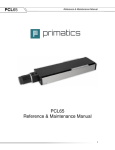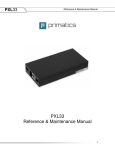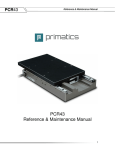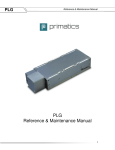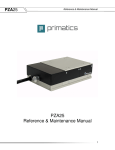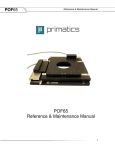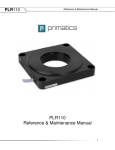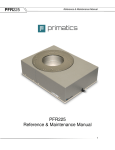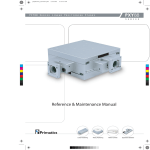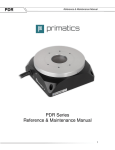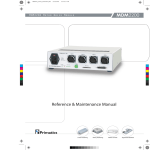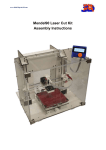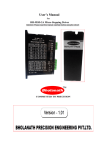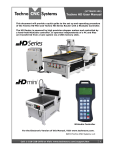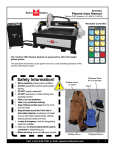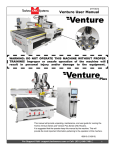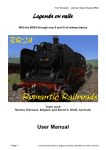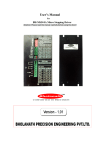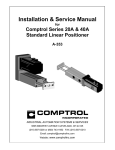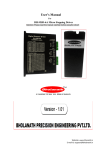Download PZB25 Reference & Maintenance Manual
Transcript
PZB25 Reference & Maintenance Manual PZB25 Reference & Maintenance Manual 1 PZB25 Reference & Maintenance Manual 32114 Mallard Ave. PO Box 409 Tangent, OR 97389-0409 U.S.A. Phone: Fax: Web: E-mail: [541] 791-9678 [541] 791-9410 www.primatics.com [email protected] PZB25 Manual Revision Information Publication Date Dec 2015 Notes As Issued Notice: The descriptions, drawings, and specifications contained herein are subject to change. Primatics is not responsible for errors or omissions herein or for incidental damages in connection with the furnishing or use of this information. This document shall not be reproduced, photocopied, or duplicated, in whole or in part, without prior written approval of Primatics Corporation. For Specifications, Dimensioned Drawings and additional information, refer to the PZB25 Datasheet available from our website at www.primatics.com. ©Copyright 2015 by Primatics, Inc; All Rights Reserved. Primatics, the Primatics logo, PrimaFlex, PrimaSeal & SimpleMatch are trademarks of Primatics, Inc. 2 PZB25 Reference & Maintenance Manual PZB25 Manual Revision Information ................................................................. 2 1) Overview .......................................................................................................... 4 2) Introduction – About the PZB25 .................................................................... 5 3) Personal Safety ................................................................................ 6 4) Conventions .................................................................................................... 7 4.1) Direction of Motion ........................................................................................................ 7 4.2) Units of Measure ........................................................................................................... 7 5) Installation Preparations ................................................................................ 8 5.1) Heat and Humidity ......................................................................................................... 8 5.2) Contamination ............................................................................................................... 8 5.3) Electrical Noise.............................................................................................................. 9 6) Installation Procedures ................................................................................ 10 6.1) Tools you will need ...................................................................................................... 10 6.2) Unpacking ................................................................................................................... 10 6.3) Mounting surface preparation ...................................................................................... 10 6.4) Mounting a motor to the PZB25 ................................................................................... 11 6.5) Mounting the PZB25 .................................................................................................... 12 6.6) Electrical Connections ................................................................................................. 14 6.6.1) Limit Sensor Connector ............................................................................................ 14 6.6.2) Step Motor Option .................................................................................................... 14 6.6.3) Failsafe Brake Option ............................................................................................... 14 6.7) Limit Switches ............................................................................................................. 15 6.8) Recommended System Test ........................................................................................ 16 7) Preventive Maintenance ............................................................................... 17 7.1) Lubrication .................................................................................................................. 17 8) Troubleshooting & Service .......................................................................... 18 8.1) Troubleshooting Help .................................................................................................. 18 8.2) Service ........................................................................................................................ 18 3 PZB25 Reference & Maintenance Manual 1) Overview This user guide is designed to help you install and maintain your PZB25 Series vertical positioning stage application. Follow these steps to ensure correct stage installation and maximum stage life: Step 1 Review this entire user manual. Become familiar with all installation procedures prior to integrating your system. Step 2 Review the safety summary to develop an understanding of standard safety practices when installing and operating automated equipment. Step 3 Familiarize yourself with the conventions summary. Step 4 Review installation procedures. For best results, follow these procedures carefully. Step 5 Once you successfully complete all the installation procedures, you will be ready to install and operate your stage. Step 6 Review preventive maintenance section for proper lubrication schedule. 4 PZB25 Reference & Maintenance Manual 2) Introduction – About the PZB25 The PZB Series is a general purpose ballscrew-driven elevator stage with NEMA 17 motor mount. It utilizes a moving wedge design that converts horizontal movement from a ballscrew to vertical elevation. The design and components ensure sub-micron resolution in a compact profile and make the PZB ideal for semiconductor inspection, fiber optics assembly and machine vision applications requiring smooth motion, exceptional stiffness, and high resolution. The PZB25 can be ordered with a motor, either stepper or brushless servo with encoder. A failsafe brake is also a standard ordering option. The user may also supply their own motor compatible with the NEMA17 mount. 5 PZB25 Reference & Maintenance Manual 3) Personal Safety Please review before installing your positioning stage Observe common industrial safety practices when installing and operating automated equipment. o Have power connections made by qualified personnel. o Keep fingers and other items out of any opening in the stage while it is in operation since injury or damage may result. o Provide a safe access route and adequate room for servicing. o Perform the recommended periodic maintenance described in this document. o Verify that the work envelope is free of obstructions before the positioning stage is powered. o Insure that you have the feedback wired properly to the controller before applying power to the positioning stage. Improper feedback connections can cause a motor run-away condition that has the potential to damage the stage and injure an operator. o Only trained operators of the positioning stage should be allowed near the work environment. o If so equipped, identify emergency stop circuits and actuators in the workcell. o Note the places in the workcell where pinch points occur, and provide adequate safety clearance or safety curtain. o Never operate the motor in a location that could be splashed by water, exposed to corrosive or flammable gases or is near combustible substances since this may cause an electric shock, fire or malfunction. o Never touch the motor, driver, or peripheral devices when the power is on or immediately after the power is turned off. The high temperature of these parts may cause burns. 6 PZB25 Reference & Maintenance Manual 4) Conventions 4.1) Direction of Motion The positive direction of motion is defined as when the carriage elevates upward (overall height of stage increases). Figure 4-1 illustrates this convention. Positive (Forward) Motion Optional Motor Figure 4-1: PZB25 Conventions 4.2) Units of Measure Primatics uses the metric system for all specifications and dimensions. All linear dimensions are specified in millimeters. Accuracy, repeatability, resolution, flatness and straightness for the PZB is specified in microns. Load capacity is specified in kilograms and moment capacity is given in Newton-meters. All torque specifications are given in Newton-meters. Thrust specifications are given in Newtons. The following table gives some common conversions into English units: Metric Unit English Unit 1 Kilogram equals 0.0685 slug* 1 micron equals 0.0000394 inch 1 millimeter equals 0.0394 inch 1 Newton-meter equals 8.85 in-lbs 1 Newton equals 0.2248 lbs *1 Kg has a weight of 2.205 lb when g = 9.8 m / s2 7 PZB25 Reference & Maintenance Manual 5) Installation Preparations This section outlines installation environments. Unfavorable installation conditions may cause electric shock, fire, or breakdown. Certain breakdown situations or malfunctions in particular may lead to serious injury or other consequences. Assure that the unit is used under the following installation conditions: o o o o o o Indoors, free from being splashed by water No corrosive or inflammable gases present Well ventilated place, minimum level of dust or waste An environmental temperature range between 0-40°C, and humidity between 2080% RH (location with no condensation) Note - These values show the range in which operation can be carried out safely, but not the environmental range in which stages accuracy can be guaranteed. Stage accuracy can be guaranteed at 20°C +/- 1°C. Location should not be affected by electrical noise. Location should be where inspection and cleaning can be performed without difficulty. 5.1) Heat and Humidity All positioning stages are assembled and tested at 20C. Any stage calibrations are also performed at 20C. For optimum accuracy the ambient temperature should be maintained at 20°C. Deviations from this nominal temperature may result in degraded accuracy performance. Ballscrew driven stages are also susceptible to thermal expansion effects. The ballscrew nut can create a localized thermal gradient if driven at high speeds. Airflow through the stage can help minimize ballnut heating. 5.2) Contamination Applications in dirty or dusty environments require the electrical, optical and mechanical components to be protected. The PZB25 series is intended for clean environments free from small particulates and fluids. The air the PZB25 is operated in should be clean and dry. The cover protection and high-pressure (60-120psi)/low flow air purge system is sufficient for environments generating moderate quantities of 0.5 mm and larger particles. However, for dusty, wet, or harsh environments or applications with continuous exposure to smaller contaminants, additional protection must be designed. Airflow through a stage must be filtered and dry. The filtration system should reject particles larger than 2 microns. Air pressures between 60-100 psi are sufficient for convection cooling. A typical air source can be made suitable with the addition of an inline desiccant dryer and filter/regulator assembly. Humidity should be less than 85% and there should be no condensation in the environment in which the stage is used. 8 PZB25 Reference & Maintenance Manual 5.3) Electrical Noise Electrical noise is the corruption of signals carried over low voltage wires. Encoder signals can be corrupted resulting in spurious encoder counts thus causing the stage to drift. Grounding, shielding, and spatial separation are all countermeasures to reduce the influences of electrical noise on performance. You can minimize the potential for electrical noise by observing the following installation precautions: o o o Physically separate low voltage conductors from those carrying high voltage. Ensure that all components are properly grounded. Ensure that all wiring is properly shielded. 9 PZB25 Reference & Maintenance Manual 6) Installation Procedures 6.1) Tools you will need The PZB25 positioning stage has mounting holes for M5 SHCS in the base and M4 and M5 tapped holes in the tabletop. M3 BHCS’s are used to attach the covers. The lower rear cover must be secured with M3 x 5mm long fasteners. Longer fasteners will result in damage to the stage. A 2mm hex tool will remove all the hard cover screws. 2.5mm hex tool is used for the coupling. 3mm and 4mm hex tools are required for the stage mounting hardware. 6.2) Unpacking Carefully remove the stage from its shipping crate and inspect it for evidence of shipping damage. Report any damage immediately to your authorized dealer. Improper handling of the stage may degrade its performance. Follow these guidelines when handling and mounting your stage. 1) Do not drop the stage onto its mounting surface. Place the stage gently on the mounting surface. Impact loads can cause high spots on mounting surfaces, misalignment of drive components and warping of the base. 2) Do not drill holes into the stage. If additional holes are necessary, contact your local distributor. 3) Lift the stage by its base structure only. Do not lift by the motor drive assembly. 4) Stage disassembly and alteration, unless specified otherwise, may void warranty. 6.3) Mounting surface preparation The characteristics of the surface the positioning stage is mounted to will have a large effect on system performance. An accurate and flat positioning stage will conform to the shape of its mounting surface, therefore a flat mounting surface is required. For best results in maintaining stage specifications we suggest the following: 1) Use a laboratory Grade AA granite surface plate 2) Before mounting stage, inspect for burrs or dings on the stage mounting surfaces 3) Clean all mounting surfaces with acetone In the absence of a granite surface plate, we recommend a base plate made of the same material as the base of the stage. A mounting surface constructed out of a material different from the stage base material can introduce warping in the stage in the presence of a thermal gradient. The surface flatness should match the requirements of the application; a good starting point is to have the mounting surface flat to less than 5-8μm. 10 PZB25 Reference & Maintenance Manual 6.4) Mounting a motor to the PZB25 The following text and illustrations give instructions to mount a motor onto the PZB25 1 - Remove upper rear cover using a 2mm hex tool. 2 - Using a M4 hex tool inserted into the end of the internal ballscrew, rotate the screw to raise the PZB to maximum height. 3 - Remove the motor mount using a M3 hex tool to remove the two indicated fasteners. 4 – Attach the motor to the motor mount 11 PZB25 Reference & Maintenance Manual 5 - Insert the motor shaft into the coupling and then fasten the motor mount to the stage. Tighten the coupling onto the shaft by inserting a M2.5 hex tool as indicated. Replace the upper rear cover. 6.5) Mounting the PZB25 The following text and illustrations give instructions to accessing the PZB25 Mounting Holes. 1 - Remove upper rear cover using a 2mm hex tool. 2 - Using a M4 hex tool inserted into the end of the internal ballscrew, rotate the screw to raise the PZB to maximum height. 12 PZB25 Reference & Maintenance Manual 3 - Remove the lower cover using a 2mm hex tool to gain access to the indicated mounting holes along the base of the stage. After mounting, replace the lower then upper rear covers. Use only M3 x 5mm fasteners on the lower cover 13 PZB25 Reference & Maintenance Manual 6.6) Electrical Connections 6.6.1) Limit Sensor Connector All configurations of the PZB25 include a connection for the internal limit sensors described in Table 6-1 Table 6-1: Limit Connector: Dsub 9 with pins Pin 1 2 3 4 5 6 7 8 9 Function Limit Power (5 to 24VDC, 50mA) Limit Power and Signal Common Forward (upper) Limit Reverse (lower) Limit Not used Not used Not used Not used Not used 6.6.2) Step Motor Option Table 6-2: Step Motor Connector : Dsub 9 with pins Pin 1 2 3 4 5 6 7 8 9 DSub9 with pins Motor A+ Motor AMotor case Motor B+ Motor BNot used Not used Not used Motor Shield (no internal connection) 6.6.3) Failsafe Brake Option Table 6-3: Failsafe Brake Connector Molex MiniFit Jr 1x2 plug with pins Mating connector: Molex 39-01-2020 with Molex 39-00-0039 sockets Pin 1 2 Function Brake + (24VDC to release brake) Brake – (Common for brake release) 14 PZB25 Reference & Maintenance Manual 6.7) Limit Switches A home sensor is not present because the PZB25 was designed with the idea of finding a home position near the reverse limit of travel. This facilitates moving downward (normally out of harms way) in the homing process. The anticipated homing procedure would be to search for the reverse limit sensor transition and then move up, off the sensor. The Limit switches are ordered in either the Normally Closed (L1) or Normally Open (L2) configuration L1: When the carriage is in the normal operating range of travel, both limit switches are closed. When the carriage encounters a limit the switch opens. The switch will close again when the carriage is moved away from the switch. L2: When the carriage is in the normal operating range of travel, both limit switches are open. When the carriage encounters a limit the switch closes. The switch will open again when the carriage is moved away from the switch. The limit switch positions have been preset at the factory and cannot be adjusted. Figure 6-3 shows the relative placement of the limit transitions. Both limit switches can be ordered normally open or normally closed. Figure 6-1: PZB25 Limit Sensors 15 PZB25 Reference & Maintenance Manual 6.8) Recommended System Test Before attaching a load or applying power to your stage, verify the encoder, if present, and limit switches are working properly. Move the stage hand by manually rotating the motor or inserting a M4 hex tool in the rear of the stage to engage the internal ballscrew. Runaway conditions caused by miswired encoders can result in stage damage and personal injury. When closing the position loop for the first time, set the torque limit of your controller to a low value and use conservative tuning gains. Once the control loop is working properly, payloads can be added to the stage carriage. 16 PZB25 Reference & Maintenance Manual 7) Preventive Maintenance Performing preventive maintenance procedures on your stage will extend its life and improve its long-term performance. 7.1) Lubrication Use clean room grease to lubricate the ballscrew and linear guide components. We recommend NSK grease part #GRS LG2. For low duty cycle applications, it is recommended that the ballscrew and linear guides are re-greased every six months. High duty cycle applications may require more frequent re-lubrication. Lubrication intervals depend on duty cycle, load and ambient conditions. Inspection of the drivetrain elements may be required to determine the proper lubrication interval. Primatics offers a grease kit that has all the necessary hardware to re-lubricate the ballscrew and linear bearings. To gain access to component grease ports, remove the covers. On the end of each bearing block is a small hole where grease is injected using a syringe. A light film can also be applied the linear bearings when the stage is at one extreme end of travel. After power has been disconnected from the stage, a light film of grease can be smeared along the length of the ballscrew. Cycle the stage back and forth to distribute the grease and wipe off any excess. The stage should be kept clean and a soft cloth should be used wipe down the stage. Do not use compressed air to spray away dust since this may force dust into crevices. Figure 7-1: Bearing block lubrication port 17 PZB25 Reference & Maintenance Manual 8) Troubleshooting & Service 8.1) Troubleshooting Help For further assistance contact the factory: M-F 8AM to 5PM Pacific Time Phone: Fax: Web: E-mail: [541] 791-9678 [541] 791-9410 www.primatics.com [email protected] 8.2) Service Should your device require factory service, contact the factory for a Return Materials Authorization (RMA). When inquiring about an RMA please have the following information available: o Your contact information (name, phone, email, address) o Unit Serial Number (see Figure 8-1) o Symptom of problem o History of troubleshooting steps already taken Figure 8-1: Unit Serial Number Location 18


















